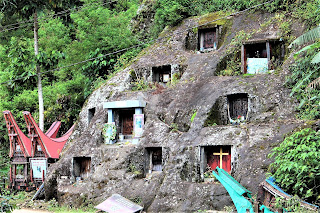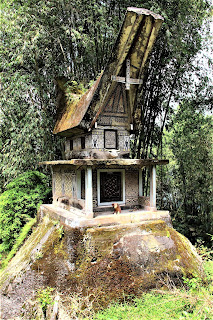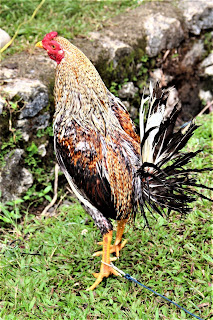A cultural experience in Sulawesi, Indonesia in 2012
(Travel Story Series @ Hon Too Fang 2020)
This is a travel account to a place nearer home.
Two weeks ago (in August 2012) 4 of us (including my wife) visited Makassar and Tana Toraja in Sulawesi, Indonesia, for some cultural experiences. A short account here. Less words, more photos. Hope you are further educated culturally.
Makassar and Tana Toraja are places in the Island of Sulawesi, east of Kalimantan. The island of Sulawesi is shaped like the letter ‘K”. Makassar is located on the left southern tip. The region of Toraja is in the middle. In between is the region of the Bugis, the tribe of our Ah Jib Ko.
1: Why Sulawesi: Story in a story
So why Sulawesi? There is a story. After the Euro 2012 (football tournament), we the football fans had a lunch to talk about the games. We were asking our football betting man PS how was his betting account for the tournament. At this moment my friend Peter called, and asked me where would be my next travel destination.
At the critical time, PS the "Hokkien lang" shouted annoyingly, "su ka bei si " or "lost like mad" colloquially or "lost heavily" scholarly. My pariah RM 90 Nokia hand phone didn't transmit the words in HD. So Peter heard someone was saying "Sulawesi". He thought it was me. Peter the petroleum engineer said, "Ah, Sulawesi, I have been there in my oil and gas assignment days". So I looked up what was in Sulawesi and Su Ka Bei Si we went.
2: What Sulawesi offers
The main tourist attraction is the region called Tana Toraja in the central highlands, inhabited by indigenous people still practising some old traditions and continuing their cultural heritage at this cyber age. The word "Toraja" means "People of the Highlands", and "Tana" is "tanah" lah, without the h-assle. The main town is Rantapao. But first we have to fly to Makassar, capital of Southern Sulawesi. The road journey from Makassar to Rantapao was around 350 km, half of it 2-lane narrow winding country roads. It took us some 8 hours in a rented Toyota Avanza, driven by Pak Sokri.
We also spent a day in Makassar roaming around the city centre and a few special sights.
3: Makassar (1): The airport
Makassar has a population of some 1.3 million. It has a relatively new airport. But the setting lacks the "prestige" associated with "expensive" air travel. Several stalls were set up at the foyer to conduct "Ramadan" sales of clothing. Inside the departure hall, there is a shop called "Mini Mart". Have you ever seen a shop so "ordinarily-named" in an airport? The colour scheme is like our 7-11. The airport is guarded by a Bugis warrior.
4: Makassar (2): The Al Makas Mosque
This is the biggest and oldest mosque in Makassar where Islam is the dominant religion. But stalls were erected in the mosque compound for Ramadan sales, selling clothing, food stuff, etc. There were even stalls in the corridors. Rubbish everywhere, just like the ground of a pasar malam. Isn't it too profane?
5 Makassar (3): The Catholic Church
Christians are a minority here. We attended a Sunday morning (5/8/2012) mass at the Catholic Church of St Francis Assisi. Full house, about 700 to 800 people. In Bahasa Indonesia of course, and Allah is how they call my Christian God. A--min.
6 Makassar (4): The Chinese in Makassar
The Chinese started settling in Sulawesi in the 17th century. According to a Jakarta Post report in 2006 there are some 30,000 Chinese in Makassar. About 2.5% of the population. They are said mostly of the Hakka clan. We visited a Chinese association building, for the people with roots in the Guangdong province in China.
7 Makassar (5): The Chinese temples
Visited 2 Taoist temples. Shown the main deity of "Ma Chu 妈祖" at the "Tian Hou Gong 天后宫", and the temple and the deity of "Er Lang Shen 二郎神" at the "Long Xian Gong 龙显宫".
People greet you in Bahasa (B Indonesia) in a Chinese temple. Have to feel very funny!
8 Makassar (6): Bantimurung National Park
Visited the park with a 15-meter high waterfall. The entrance is guarded by Prince Kong, the third son of King Kong. And guarding Prince Kong is a giant butterfly. In fact the park is famous for butterflies, with over 100 species and several endemic species too, and they attract butterfly hunters, digitally I mean. But these two are not filming the butterflies at the moment of my shot, but some mammals in the water.
9 Makassar (7): Protere Port
This is their old port for junks and fishing boats where manpower is preferred over forklifts. The underwear and the national flag are “flying” on the same mast.
10 Makassar (8): Fort Rotterdam
This is a fort built by the locals in 1545 and expanded by the Dutch when they took over in 1614. It was the military headquarters of the Dutch for this region until the 1930s.
11 Who lives in Tana Toraja?
The Torajan is an ethnic group indigenous in this region of Tana Toraja. Overall there are some 650,000 of them, with about 450,000 still living in Tana Toraja while the others are migrant workers somewhere. Shown faces of young girls, two Muslims and a Christian.
12 What are the tourist attractions in Tana Toraja?
There are 3 main elements of the unique cultural heritage of these highland tribes: (1) distinctive architecture of their houses (2) elaborate funeral rites and rituals, and (3) strange arrangement of hanging their coffins on cliffs or having graves carved out from rocks.
We had 2 full days but were unlucky not to witness any funeral rite. We visited half a dozen villages and burial grounds.
The Torajans are mostly Christians, conversions started in the early 1900s. Both Catholics and Protestants. In fact conversion to Islam started around the same period. In their Torajan language, "pig" is called "solata" or "our friend". Islam is less appealing because Islam considers their friend "haram". So more Torajans converted to Christianity. Shown an old coffin with one end shaped like a pig at the Village of Kete Kesu.
13 Tana Toraja (1): Traditional houses or the tongkonan
These houses have elongated pitched roofs, decorated with painted patterns, buffalo horns, etc. A very inefficient way to build a roof, kind of wasteful. But then isn't a Benz E280's 200 hp engine also wasteful? And these Torajans have not abandoned their tradition: new ones are being built everywhere, certainly not to please the tourists. Those at the Village of Pallawa have thatched roofs while those at the Merante Village have zine roofs. With our driver Pak Sokri.
14 Tana Toraja (2): Tongkonan in a religious building
The traditional house, the tongkonan, is incorporated in the architecture of religious buildings too. In the Catholic Church of St Theresa in the main town of Rantapao, there is a tongkonan at the altar. The Protestants would probably frown on such practice, but the Catholics do accept traditional and tribal elements. The Muslims accept such tradition too, shown a tongkonan at the entrance gate of the Grand Mosque in the same city.
15 Tana Toraja (3): Coffins hanged on cliffs
Some sub-tribes hang the coffins of the deceased on the cliff faces, or left alone above elevated ground, like those at the Village of Kete Kesu.
Not sure how many sub-tribes still practice such burial method, but we certainly have passed by newer exposed coffins where foul smell still emits, like this in the 2nd photo, found in the village of Londa. The coffin covering cloth looks very new. The practice is certainly alive.
16 Tana Toraja (4): The giant grave houses on the ground
The rich may also build their grave houses on the ground. This giant 3-storey-high grave house is also in Kete Kesu. The other is a very old one found on the roadside near the Village of Lokomata. These are giant family grave houses.
17 Tana Toraja (5): Effigies or "tau-tau"
The more elaborate graves are accompanied by life-size wooden effigies of the deceased, called "tau-tau". This first one, a smiling old lady, is found on the giant grave featured in the earlier section. The 2nd photo shows those at a family grave, also in Kete Kesu.
18 Tana Toraja (6): Graves cut into rock in Lemo
The graves, together with rows of "tau-tau" on the cliff at the Village of Lemo are impressive. The Torajans believe that one can take earthly possession to the next world. So expensive gifts might be put inside the coffins, and to prevent easy theft, the coffins are thus hung high up the cliffs or buried inside the cliff face. Those in Lemo are 15 to 20 meters high.
19 Tana Toraja (7): More rock houses for the dead
There are many large rocks used for graves. The 2nd photo shows the most impressive of the "rock graves", a single giant round rock near the Village of Lokomata. The oldest grave was dated to around 1650. This one is a condo, look like space for the penthouse is still available. Locations of some new graves are marked on the rock face, yet to be cut.
20 Tana Toraja (8): More traditional graves
Of course there are also more traditional graves, like those found by the roadside in these 2 photos. Some are marked with a cross, Christian graves.
21 Tana Toraja (9): Baby graves inside a tree
At the Village of Sangalla, there is a huge tree where babies were buried inside the trunk. The graves, more than half a dozen, were cut into the tree trunk, and the ages of the babies were said to be from new-born to 7 years old. But such grave-in-tree tradition is no longer being practiced for some 10+ years already. We had to pay a small fee to come near the tree, guarded by some neighbourhood youngsters. One and only tree with such unique graves.
22 Tana Toraja (10): Farms
Most of the people are farmers. And rice and spices are the main produces. Shown a rice field, a sweet potato field, a young farmer and drying of rice stalks on the rocks by the roadside.
23 Tana Toraja (11): Cock fights
Cock fight, with bets, is the usual past time of the Torajans. Shown a fighting cock having its claws "serviced". When the men are free, they "talk cock".
24 Tana Toraja (12): The "flower" water buffalo
The water buffalo is a priced animal for the Torajans. They are used as sacrifice in funeral and other traditional rituals. And the "kerbau bunga" or water buffalo with pinkish skin and dark patches are highly sought after to add prestige to the occasion. This one is being cleaned and hand-fed. Our driver Pak Sokri said this one would probably cost more than the Toyota Avanza we rented, somewhere near to RM 50,000. Anyone thinking of making billions by cloning them better start early. Air Asia flies to Makassar 3 times a week!
25 Tana Toraja (13): The "bridal" limousine
Happen to catch a shot of a "bridal" car and may be the mother-in-law on high heels. It is logical to use a 4-wheel drive in this mountainous region.
26 Tana Toraja (14): The "sale" of politicians
There is practically no advertisement board on consumer products along the rural roads. People have no buying power. The only things on sale are the politicians, many advertisement boards in fact.
27 Photo of the Tour
Shown is a fake fish-eye photo of a typical village with the tongkonan, taken by PT. "Fake" in the sense PT's Olympus is not fitted with a fish-eye lens, but Olympus has a software feature to distort images to look like "fish-eye" shots. My Canon also can do that but PT's shot looks better.
**************************************
That's all folks. Hope you are educated a little bit more. Our World is more interesting than you think.
(First written in the email format in August 2012. Revised to this PDF format in December 2020)





























































